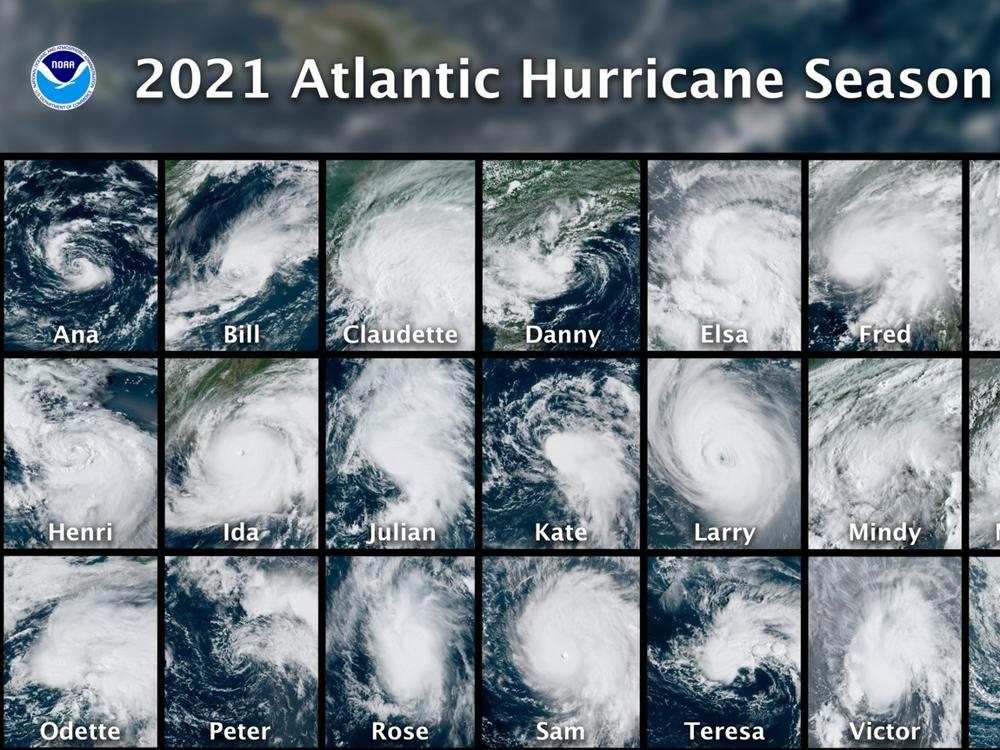Section Branding
Header Content
The 2021 Atlantic hurricane season ends as the third most active year ever
Primary Content
The 2021 Atlantic hurricane season is now officially over, ending a period in which eight storms smacked into the U.S. coast. With 21 named storms, 2021 ranks as the third most active year in history, according to the National Hurricane Center.
Here are some of the things that set the 2021 season apart:
Storms inflicted deaths and expensive damage
While repairs and recovery efforts are ongoing, the 2021 Atlantic season will likely go down as one of the most expensive in history. Hurricane Ida alone accounts for more than $60 billion in damages — making it one of the five most costly U.S. hurricanes on record since 1980, according to the National Oceanic and Atmospheric Administration.
Ida hit Louisiana as a Category 4 hurricane with a dangerous storm surge and strong winds, and it remained dangerous and destructive for roughly 1,000 miles, as it brought catastrophic flooding to the mid-Atlantic.
Ida was blamed for 26 deaths in Louisiana, and at least 50 deaths in the Northeast.
Four storms — Tropical Storm Elsa in July, Tropical Storm Fred in August, Hurricane Nicholas in September and Ida in August and September — each inflicted more than $1 billion in costs, NOAA said.
We ran out of names again
Because of the above-average number of named storms, 2021 is the second straight year in which meteorologists ran out of names for the cyclones after Wanda was dubbed in early November.
It's the first time forecasters have used up the World Meteorological Organization's initial list of names in two consecutive years.
The average is 14 named storms in a year, the NHC says. Before 2020, the only other time forecasters ran out of names was in 2005.
The 2021 season roared to an early start
The 2021 season continued a trend of unusually early cyclones, as it became "the seventh consecutive year with a named storm forming before the official start to the season on June 1," according to the NHC.
The first storm was Tropical Storm Ana, which formed north of Bermuda on May 23.
The final two months of the season were relatively quiet, after nine new named storms formed in September: Larry, Mindy, Nicholas, Odette, Peter, Rose, Sam, Teresa and Victor.
Climate change is part of the dynamic
"Climate factors, which include La Niña, above-normal sea surface temperatures earlier in the season, and above-average West African Monsoon rainfall were the primary contributors for this above-average hurricane season," said Matthew Rosencrans, lead seasonal hurricane forecaster at NOAA's Climate Prediction Center.
In August, the Intergovernmental Panel on Climate Change issued an assessment report saying it was highly confident "that the global proportion of tropical cyclones that reach very intense (category 4-5) levels, along with their peak winds and rainfall rates, are expected to increase with climate warming at the global scale," the NHC said.
Only two years on record were busier
The busy 2021 season is eclipsed only by the 27 named storms (and one unnamed storm) that were recorded in 2005, and by the record 30 named storms of 2020.
Copyright 2021 NPR. To see more, visit https://www.npr.org.

